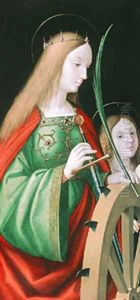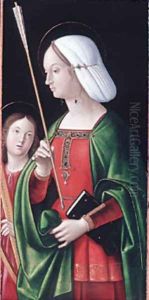Solario Andrea Paintings
Andrea Solario, born around 1460 in Milan, Italy, was a notable painter during the Italian Renaissance. Although the exact date of his birth is not known, most scholars agree on the circa estimate. He was greatly influenced by the works of Leonardo da Vinci, which is evident in his use of sfumato and careful studies of light and shadow. Solario's brother, Cristoforo Solari, also known as Il Gobbo, was a sculptor and architect, suggesting that Andrea was introduced to the world of art at a young age through his family's artistic endeavors.
Solario's early works show a strong Lombard influence, but as his style evolved, he began to incorporate the characteristics of the Venetian and Emilian schools, which was common among Milanese artists of the time due to the city's position as a cultural crossroads. His travels to Venice and possibly to the court of Ludovico Sforza in Milan exposed him to the works of contemporary masters, which further refined his style. Known for his religious compositions, portraits, and altarpieces, Solario's works are characterized by their rich color palette and meticulous attention to detail.
Notable works by Solario include 'The Lamentation of Christ' (also known as 'The Dead Christ Supported by the Virgin and St. John' or 'Pietà'), which demonstrates his skill in portraying human emotion and his mastery of chiaroscuro. His painting 'Charles d'Amboise,' a portrait of the French governor of Milan, showcases his ability to capture the likeness and character of his subjects. Solario was also known for his meticulous still lifes, which were often incorporated into his larger compositions.
Andrea Solario's career was somewhat overshadowed by the brilliance of his contemporaries, such as Leonardo da Vinci and Giovanni Bellini, but he nonetheless carved out a niche for himself in the Milanese art scene. His work was appreciated for its devotional quality and its synthesis of Northern Italian and broader European influences. Solario died around 1524, with his last known work dated to 1520. His legacy lives on in the collections of major museums around the world, where his paintings continue to be studied and admired for their contribution to the rich tapestry of Renaissance art.

